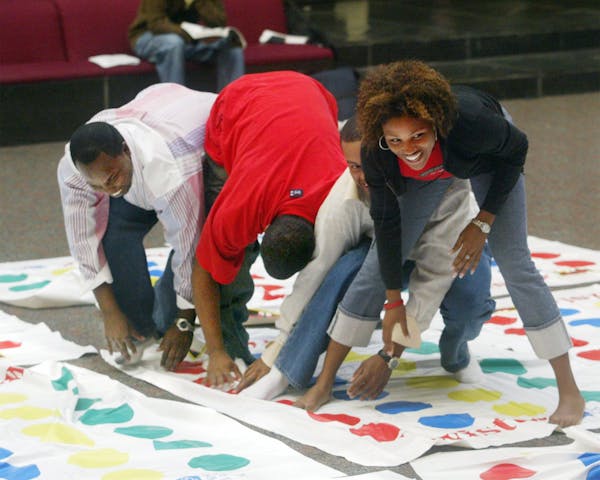On his first real attempt at developing a children's game, St. Paul ad man Reyn Guyer came up with a novel idea: using humans as board pieces.
It was with that core principle that Twister, the party game that forces players to contort themselves in awkward and amusing positions, was born.
Nearly 50 years later, it remains a cult phenomenon — virtually unchanged from the original 1966 concept that provided only a vinyl polka-dot mat and a spinner. An estimated 65 million people have played the game that invaded pop culture, once entangling the characters from "Friends" into a giant heap on the colored dots while trying to reach right-hand-on-red.
Twister was inducted into the National Toy Hall of Fame on Thursday, joining the puppet and Super Soaker as this year's class of playthings that stand the test of time.
"Some saw Twister as a passing fad, but large-scale Twister matches, popular on college campuses in the 1980s, boosted sales," said Nicolas Ricketts, curator at The Strong museum where the hall of fame is housed.
As co-inventor of the game, Guyer said he was delighted but unsurprised by the distinction. Twister's longevity comes from its inherent uniqueness, he said.
"Important breakthroughs usually break a rule, where people have formerly said 'you can't do that.' Twister broke that kind of a rule," said Guyer, now 80 and living in Florida. "It allowed people to be more intimate in a fun, social setting."
But its creativity was also fuel for controversy for Twister's critics, who labeled the game "Sex in a Box" because of its ability to put players of the opposite sex in extremely close and often provocative positions.
However, the icebreaker game's beginnings are far more innocuous. While working for his father's commercial design firm, Guyer was tinkering with colored polka-dot play mats for a promotional shoe polish display. When he began testing the product, originally dubbed "King's Footsie," with family and friends on a big corrugated board, he realized it could be a real hit.
"It was so much fun that I knew right away there had to be something to this, because we couldn't stop laughing," said Guyer, who is also credited with inventing the Nerf ball.
He pitched the idea to 3M, but the company passed. Guyer hired game designers Charles Foley and Neil Rabens to help refine the concept, dedicating an entire division of the company to developing players as pieces. The trio created several versions of the game, the favorite being called Pretzel.
Milton Bradley Co., the nation's largest puzzle manufacturer, loved the concept but changed the name to Twister because Pretzel was not legally available. Twister debuted in 1966 with the slogan "The game that ties you up in knots" and saw minimal sales.
It may not have made it a full year on the shelves if not for Johnny Carson. Sears Roebuck deemed the game too racy for its 1966 catalog, so Milton Bradley canceled production before it ever really began. But Twister was already in the lineup for "The Tonight Show," and when the glamorous Eva Gabor enticed Carson onto the mat during live television, sales soared.
"Ostensibly the game was dead," Guyer said. "What happened on that show turned the whole thing around."
More than 3 million copies were sold in 1967, when it became the Game of the Year. The Hula-Hoop was Twister's only rival for America's fad toy of the decade, according to "Toys of the '50s, '60s and '70s," which chronicles the history behind each era's most popular playthings.
Its international success helped build the capital Guyer needed to expand into other industries, including music and education. His St. Paul-based Winsor Learning teaches remedial reading strategies to children who have dyslexia.
The Associated Press contributed to this report.
Liz Sawyer • 612-673-4648
Minneapolis to set up Lake Street Community Safety Center, and wants residents' help to define it
Searching for Snoopy: What happened to all the 'Peanuts' statues in St. Paul?
North Oaks withdraws request for density exemption from Met Council

Fall or spring, it's Rochester Mayo's year in prep tennis

